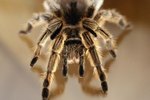
The name "shamrock spider" applies to a large genus of spiders sometimes called orb spiders. They are named for their delicate, intricate webs. Most species are mildly poisonous, but the most common species are usually safe. This widespread family occupies a variety of habitats.
Range
The Araneus genus is prevalent everywhere except the polar regions. One species, Araneus diadematus, is common in North America and Europe. This is called a "holarctic" distribution, meaning the shamrock spider is found in the Northern Hemisphere above the tropics. A. diadematus is probably the best-known shamrock spider.
Habitat Requirements
Shamrock spiders have specific habitat requirements. They require humid areas, with large, sturdy vegetation. Such spaces include grasslands, shrublands, forests, gardens and barns throughout their range. Shamrock spiders also prefer temperate climates, places that are not too cold or too hot. They prefer the same kinds of spaces that many humans do, which often brings them into contact with people.
Reasons for Their Habitats
Shamrock spiders' habitat preferences reflect the spiders' needs. High humidity is necessary so they can drink moisture that collects on their webs. Shamrock spiders need environs with sturdy vegetation or structures like barns to serve as anchor points for their webbing. Additionally, areas rich with vegetation like shrublands and forests tend to be rich in insect life, the shamrock spider's food source.
Webs
The shamrock spider's web is crucial for its survival. Shamrock spiders use their webs to collect food and water. These spiders remake their web daily, keeping it freshly made. The exact height of the web varies by species. Most species of shamrock spider create their webs at a particular distance from the ground.
References
- University of Michigan Animal Diversity Web: Araneus diadematus
- University of Michigan Animal Diversity Web: Araneus
- Bug Guide: Araneus
- Spider and Harvestman Recording Scheme Website: Summary for Araneus quadratus (Araneae)
- Spider and Harvestman Recording Scheme Website: Summary for Araneus marmoreus var. marmoreus (Araneae)
Photo Credits
-
Hemera Technologies/Photos.com/Getty Images



